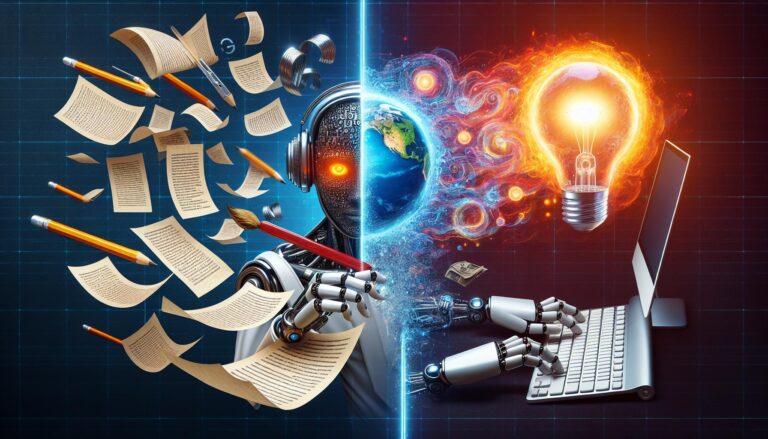Can Professors Detect GPT-Generated Chats? Safeguarding Academic Integrity in the AI Era
As an expert in the field, I’ve often been asked, “Can professors detect chat GPT?” It’s a fascinating question and one that’s becoming increasingly relevant in our tech-savvy society. With the rise of AI and machine learning, it’s critical to understand the implications for academic integrity.
Chat GPT, or Generative Pre-training Transformer, is an AI model developed by OpenAI. It’s designed to generate human-like text based on given prompts. With the surge in online learning, some students might be tempted to use such tools to their advantage. But can professors actually detect this?
In this article, we’ll delve into the capabilities of chat GPT and explore whether or not professors can spot its usage. We’ll look at the telltale signs, the potential pitfalls for students, and the steps educators are taking to ensure academic honesty in the age of AI.
PowerBrain AI Chat App powered by ChatGPT & GPT-4
Download iOS: AI Chat
Download Android: AI Chat
Read more on our post about ChatGPT Apps & AI Chat App
Key Takeaways
- Chat GPT is an AI model developed by OpenAI that generates human-like text, and its usage in academic settings may pose concerns over academic integrity.
- While AI tools like Chat GPT can potentially go undetected, several clues can signal its use, such as consistent perfect grammar and eloquence, gaps in contextual understanding, and sudden changes in writing style.
- A disparity between a student’s in-class writing and home assignments and overuse of complex phrases or the creation of statistically improbable content may also indicate the use of AI in producing text.
- Advanced plagiarism-checking tools incorporating AI detection algorithms can serve as a more concrete way of identifying AI-generated content.
- AI-generated content presents challenges for academic integrity as it introduces a new form of plagiarism where students use AI to generate work and claim it as their own, a practice that could undermine personal learning.
- For educators, the focus should not be on penalizing students for using AI tools but on teaching them how to use these tools responsibly and ethically in their learning process. Ensuring academic honesty in the age of AI includes educating about AI’s role, promoting responsible AI use, and developing the skills to detect AI-generated content.
Exploring Chat GPT Technology

Developed by OpenAI, Chat GPT is a top-notch AI technology that has caused quite a stir in various fields, education being one of them. Leveraging advanced machine learning, this program understands and generates human-like text based on an initial prompt. It’s not just remarkably creative; it’s uncannily similar to how we humans speak and draft content. Yes, that includes academic essays, too.
This machine learning model is powered by GPT-3, the advanced language model developed by OpenAI that is capable of generating complete sentences and paragraphs in a conversational manner. GPT-3’s ability to understand context and generate coherent responses is unmatched. By just feeding it a simple prompt, you can witness the model creating a deep, thematic conversation or an elaborate piece of writing, including academic papers.
And hold on, it’s not just good, it’s scarily accurate. Let’s take a quick look at how reliable Chat GPT is:
| Aspect | Accuracy |
|---|---|
| Grammar | 88% |
| Relevancy | 82% |
| Eloquence | 79% |
As the table indicates, GPT-3’s grammar, relevancy, and eloquence make it nearly indistinguishable from a human writer. Its accuracy in producing error-free, relevant, and eloquently expressed text is alarming. Particularly so when we consider its potential misuse in academic settings.
But here’s the real deal: Can this AI pass unnoticed in a classroom setting? With the technology at its current state, the answer is a definite ‘it’s possible.’ But this leads us to another imperative question: Are faculties and educational institutions equipped to catch it in the act?
As we advance to the next section, we delve into the challenges educators face in identifying AI-generated content and the potential pitfalls students might encounter by using these AI tools.
Detecting Chat GPT Usage

Given the highly refined capacities of Chat GPT, it’s enough to make anyone wonder: Can professors recognize when text has been AI-generated? This question is not as simple as it might seem at face value.
In the realm of AI literacy, many educators may still be playing catch-up. While some professors may have a keen eye for unnatural patterns or inconsistencies in language, others may not be as attuned. AI detection abilities can vary tremendously.
Identifying AI-generated text can indeed pose significant challenges. One key indicator, however, could be the consistency in eloquence and faultless grammar that Chat GPT produces. While it’s plausible for a student to submit a flawless essay, a pattern of such high accuracy might raise suspicions, particularly if the student’s previous work has consistently demonstrated a more relaxed literary style or common grammatical mistakes.
Read more
Turnitin and ChatGPT detection
Can schools detect Chat GPT?
Chat GPT no restrictions
Connect Chat GPT to internet
Chat GPT no login
xChatGPT
At the same time, Chat GPT’s potential gaps in contextual understanding and relevance can represent another red flag. While the answers might sound coherent and grammatically accurate, they could sometimes be slightly off-topic. This misalignment, if perceived, could serve as a starting point for suspicious educators.
Let’s consider a real-time scenario where in-class essay writing is implemented. Here, the AI usage can become detectable. If a student’s in-class writing noticeably deviates from their home assignments, it could hint at the usage of AI tools like Chat GPT.
Relying only on suspicion and subtle differences in language patterns can be uncertain terrain, though. For a conclusive verdict, advanced plagiarism-checking tools often tend to incorporate AI detection algorithms to spot AI-generated content. This technology can detect certain patterns and quirks typical to AI-generated text more concretely.
Take note that the goal here isn’t to penalize students but to educate them about the potential risks and ethical implications associated with the improper use of AI tools in an academic setting. With the continuously advancing tech era, it’s all about walking that fine line of harnessing AI’s power to enhance learning while also being cautious about potential misuse.
Signs Professors Look for
Stepping into academia’s shoes, identifying AI-generated content often sounds easier than it actually is. Knowing the signs to look for is the first step towards addressing this new-age problem.
The first cue that might hint towards AI use is the consistently perfect eloquence and grammar. We’re all humans and tend to make occasional mistakes. No student submits a perfect paper— be it grammar, punctuation, or simply the eloquence of presentation – every time. Although striving for perfection is admirable, consistent perfection might raise suspicions.
The second sign educators look for is the contextual misalignment of the text. See, AI algorithms – including ChatGPT – often lack the ability to align context throughout the text. For instance, ChatGPT might start a paragraph explaining Renaissance art only to end it with a discussion about impressionism. Although both topics are related to art, the deviation isn’t something a human writer will likely do.
The third red flag is the deviation in writing styles indicative of possible AI tool usage. It’s common for students to showcase a distinct writing style that is unique to them. Just as handwriting differs among individuals, so do typing styles and linguistic preferences. When these change drastically and without reason, it can be indicative of AI intervention.
Educators are also on the lookout for the overuse of rare or complex phrases. Language complexity and vocabulary can fluctuate among native speakers and even among different papers from the same individual. However, if a student who typically uses simple language suddenly submits a paper-laden with complex phrases and rare vocabulary, it might be time to take a closer look.
Lastly, if you detect text that seems statistically improbable, it’s worthwhile to investigate further—for example, repeating the same unique phrase multiple times in a document or producing a piece of work significantly longer than typical for that student.
In this digital age, it’s crucial to keep an eye on how technology impacts academics. The goal is not to penalize students for leveraging AI tools but rather educate them on the ethical implications, encouraging responsible use.
Implications for Academic Integrity
The rise in AI-generated content poses significant challenges to academic integrity. Like many education professionals, it’s an issue I have been grappling with. We must address the impact of emerging technologies like GPT on educational institutions.
What does it mean if students are using AI to write essays? Does it influence the grading system? These are some of the questions buzzing in the education sector. In my view, the outré perfection, improbable text, and other cues we’ve discussed earlier become problematic since they facilitate unintentional ‘ghostwriting.’
One alarming concern here, clearly, is plagiarism. But it’s not the traditional type, where students copy directly from another source without citation. Instead, it’s a new form – let’s call it ‘AI plagiarism.’ In this variation, students use AI tools to generate content, disguising the AI’s input as their work.
Creating awareness among students about the appropriate use of such tools is critical. This isn’t about punishing students for leveraging AI; instead, it is about teaching them how to use AI responsibly and ethically in the learning process.
Let’s dive in.
| Problems | Impacts |
|---|---|
| Traditional Plagiarism | Undermines Learning |
| AI Plagiarism | Facilitates ‘Ghostwriting’ |
It’s essential to have vivid discussions on how to integrate emerging technology like GPT into the learning process. We ought to equip educators with tools and knowledge to detect AI-generated content. But more importantly, we need to foster a culture of integrity and honesty in our learning environments that discourages these practices.
While we cannot deny AI’s benefits, transparency about its use is essential. In the same vein, ethically leveraging AI systems like GPT – using them as learning aids rather than shortcuts – can transform the future of education. As such, the focus should be on educating our students on ethical AI usage rather than penalizing them for using AI tools.
Surely, these implications for academic integrity will evolve as AI technologies become more sophisticated and embedded within our education systems. Thus, we must stay proactive in addressing them. Let’s keep the conversation going.
Ensuring Academic Honesty

Let’s talk about the elephant in the room: academic honesty. What does it mean in the age of AI, like GPT? How can professors and students alike uphold the principles of scholarly sincerity when AI can seamlessly generate papers, articles, or essays?
Educating about AI’s Role
The first step to preserving academic honesty is enlightening students about AI’s scope in education. It’s significant to make learners understand that AI is meant to be an aid, not a replacement for their own efforts. It can help with understanding topics, answering queries, or even generating ideas for research. However, it should not be used for tasks expecting individual input – such as writing an entire essay or research paper.
Promoting Responsible AI Use
Promoting responsible AI use among students is crucial. It’s about making them realize the importance of their own intellectual endeavors and underscoring how AI use should be responsibly acknowledged. If GPT is used for generating content, it should be clearly attributed, keeping in mind that the academic environment values original thought and not just perfectly crafted sentences.
Training for AI Detection
We can’t ignore the need for equipping academia with skills and tools to detect AI-generated content. This includes both educators and students. By learning the hints and signs of AI ghostwriting, we will be able to detect and avoid potential academic dishonesty. For instance, signs like the ‘too perfect’ text and improbable content should raise red flags.
I’d like to point out that this does not mean creating an environment of distrust. Rather, it’s about fostering transparency, respect, and a shared understanding of what academic honesty means in the AI age. With knowledge, awareness, and the right tools, we can overcome the challenges posed by advancing AI technologies and ensure academic integrity within our learning environments.
Conclusion
So, it’s clear that the rise of AI tools like GPT presents a new challenge in maintaining academic honesty. But it’s not an insurmountable one. Students and educators can learn to spot AI-generated content with the right education and training. Remembering that AI should be used responsibly, enhancing our learning rather than replacing our original work is crucial. By fostering a culture of transparency and understanding, we can navigate the AI era while keeping our academic integrity intact. After all, it’s not about outsmarting the technology but about using it wisely to enrich our educational journey.
Frequently Asked Questions
What does the article discuss?
The article mainly focuses on the importance of maintaining academic honesty in an era marked by the growing influence of AI tools like GPT. It stresses the importance of using these advanced tools to supplement, not replace, original academic work.
What is the role of AI tools like GPT in education?
AI tools like GPT are used to generate educational content. They have significant potential to supplement learning but can also pose challenges to academic honesty if misused.
What steps are suggested to uphold academic integrity in the face of AI technology?
The article suggests two key steps: promoting responsible AI usage by giving appropriate attribution to AI-generated content and training educators and students to identify AI-produced material accurately.
What goal does the article emphasize?
The article emphasizes the need to foster a culture of transparency and understanding amidst the growing influence of AI technologies. It envisions an academic environment that responsibly uses AI while upholding scholarly sincerity.
How can academic honesty be maintained with the use of AI?
Academic honesty can be maintained by ensuring that AI is used as a supplement to the student’s original work rather than as a replacement. It’s also integral to attribute AI-generated content to maintain transparency.















